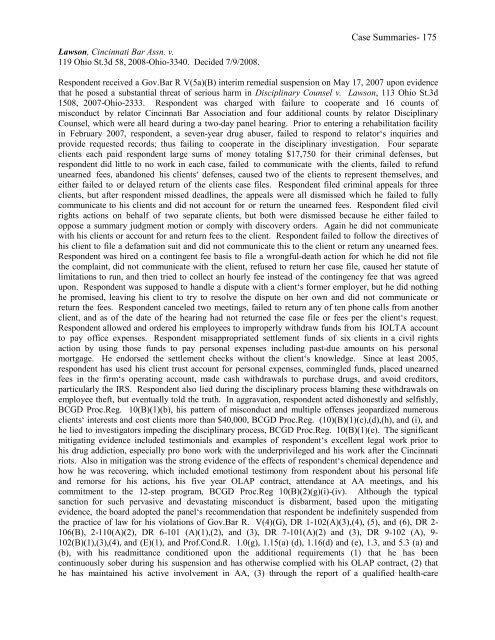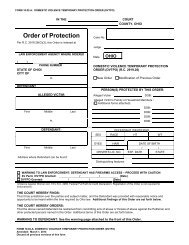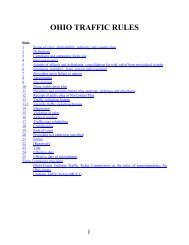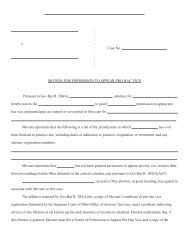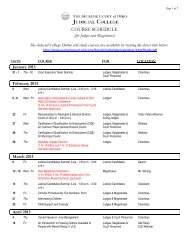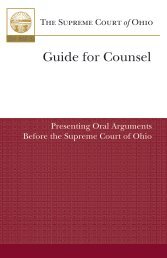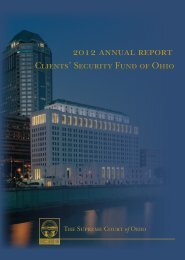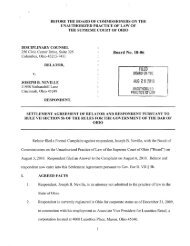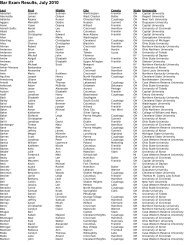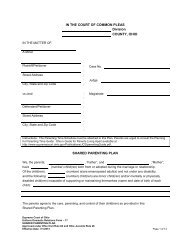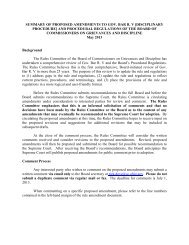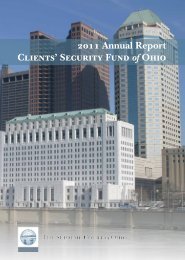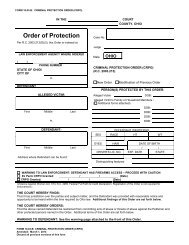disciplinary handbook: volume v - Supreme Court - State of Ohio
disciplinary handbook: volume v - Supreme Court - State of Ohio
disciplinary handbook: volume v - Supreme Court - State of Ohio
Create successful ePaper yourself
Turn your PDF publications into a flip-book with our unique Google optimized e-Paper software.
Lawson, Cincinnati Bar Assn. v.119 <strong>Ohio</strong> St.3d 58, 2008-<strong>Ohio</strong>-3340. Decided 7/9/2008.Case Summaries- 175Respondent received a Gov.Bar R V(5a)(B) interim remedial suspension on May 17, 2007 upon evidencethat he posed a substantial threat <strong>of</strong> serious harm in Disciplinary Counsel v. Lawson, 113 <strong>Ohio</strong> St.3d1508, 2007-<strong>Ohio</strong>-2333. Respondent was charged with failure to cooperate and 16 counts <strong>of</strong>misconduct by relator Cincinnati Bar Association and four additional counts by relator DisciplinaryCounsel, which were all heard during a two-day panel hearing. Prior to entering a rehabilitation facilityin February 2007, respondent, a seven-year drug abuser, failed to respond to relator‘s inquiries andprovide requested records; thus failing to cooperate in the <strong>disciplinary</strong> investigation. Four separateclients each paid respondent large sums <strong>of</strong> money totaling $17,750 for their criminal defenses, butrespondent did little to no work in each case, failed to communicate with the clients, failed to refundunearned fees, abandoned his clients‘ defenses, caused two <strong>of</strong> the clients to represent themselves, andeither failed to or delayed return <strong>of</strong> the clients case files. Respondent filed criminal appeals for threeclients, but after respondent missed deadlines, the appeals were all dismissed which he failed to fullycommunicate to his clients and did not account for or return the unearned fees. Respondent filed civilrights actions on behalf <strong>of</strong> two separate clients, but both were dismissed because he either failed tooppose a summary judgment motion or comply with discovery orders. Again he did not communicatewith his clients or account for and return fees to the client. Respondent failed to follow the directives <strong>of</strong>his client to file a defamation suit and did not communicate this to the client or return any unearned fees.Respondent was hired on a contingent fee basis to file a wrongful-death action for which he did not filethe complaint, did not communicate with the client, refused to return her case file, caused her statute <strong>of</strong>limitations to run, and then tried to collect an hourly fee instead <strong>of</strong> the contingency fee that was agreedupon. Respondent was supposed to handle a dispute with a client‘s former employer, but he did nothinghe promised, leaving his client to try to resolve the dispute on her own and did not communicate orreturn the fees. Respondent canceled two meetings, failed to return any <strong>of</strong> ten phone calls from anotherclient, and as <strong>of</strong> the date <strong>of</strong> the hearing had not returned the case file or fees per the client‘s request.Respondent allowed and ordered his employees to improperly withdraw funds from his IOLTA accountto pay <strong>of</strong>fice expenses. Respondent misappropriated settlement funds <strong>of</strong> six clients in a civil rightsaction by using those funds to pay personal expenses including past-due amounts on his personalmortgage. He endorsed the settlement checks without the client‘s knowledge. Since at least 2005,respondent has used his client trust account for personal expenses, commingled funds, placed unearnedfees in the firm‘s operating account, made cash withdrawals to purchase drugs, and avoid creditors,particularly the IRS. Respondent also lied during the <strong>disciplinary</strong> process blaming these withdrawals onemployee theft, but eventually told the truth. In aggravation, respondent acted dishonestly and selfishly,BCGD Proc.Reg. 10(B)(1)(b), his pattern <strong>of</strong> misconduct and multiple <strong>of</strong>fenses jeopardized numerousclients‘ interests and cost clients more than $40,000, BCGD Proc.Reg. (10)(B)(1)(c),(d),(h), and (i), andhe lied to investigators impeding the <strong>disciplinary</strong> process, BCGD Proc.Reg. 10(B)(1)(e). The significantmitigating evidence included testimonials and examples <strong>of</strong> respondent‘s excellent legal work prior tohis drug addiction, especially pro bono work with the underprivileged and his work after the Cincinnatiriots. Also in mitigation was the strong evidence <strong>of</strong> the effects <strong>of</strong> respondent‘s chemical dependence andhow he was recovering, which included emotional testimony from respondent about his personal lifeand remorse for his actions, his five year OLAP contract, attendance at AA meetings, and hiscommitment to the 12-step program, BCGD Proc.Reg 10(B)(2)(g)(i)-(iv). Although the typicalsanction for such pervasive and devastating misconduct is disbarment, based upon the mitigatingevidence, the board adopted the panel‘s recommendation that respondent be indefinitely suspended fromthe practice <strong>of</strong> law for his violations <strong>of</strong> Gov.Bar R. V(4)(G), DR 1-102(A)(3),(4), (5), and (6), DR 2-106(B), 2-110(A)(2), DR 6-101 (A)(1),(2), and (3), DR 7-101(A)(2) and (3), DR 9-102 (A), 9-102(B)(1),(3),(4), and (E)(1), and Pr<strong>of</strong>.Cond.R. 1.0(g), 1.15(a) (d), 1.16(d) and (e), 1.3, and 5.3 (a) and(b), with his readmittance conditioned upon the additional requirements (1) that he has beencontinuously sober during his suspension and has otherwise complied with his OLAP contract, (2) thathe has maintained his active involvement in AA, (3) through the report <strong>of</strong> a qualified health-care


